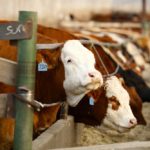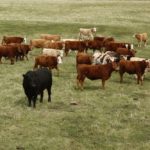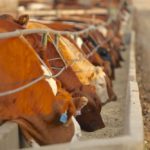Compared to last week, western Canadian feeder cattle markets traded steady to $3 higher. Strength in the deferred live cattle futures, particularly the April contract, spilt over into the cash […] Read more
Tag Archives feedlots

Klassen: Feeder market eyes April live cattle futures

Klassen: Feeder market waiting for direction
Average western Canadian feeder prices were relatively unchanged from week-ago levels; however, the yearling market in southern Alberta traded $3-$5 higher as feedlot operators focused on sourcing local cattle. High-quality […] Read more

Feed weekly outlook: Lethbridge feedlots buying U.S. corn
CNS Canada — As barley prices climb, feedlots around Lethbridge have found a cheaper feed option: corn from the U.S. “Price has (pushed feedlots to buy corn). Barley, it’s probably […] Read more

Feed weekly outlook: Alberta feedlots prepared for supply issues
CNS Canada — Many regions of the Prairies expect some feed shortages this year, but Alberta feedlots have plans ready to deal with those issues. Bryan Walton, CEO of the […] Read more

Prairies’ dry weather may stem U.S. cattle stampede north
Winnipeg | Reuters — Parched pastures and crops in Western Canada are driving up cattle-feeding costs, and farmers and analysts expect the changing economics to stem a recent stampede of […] Read more

Klassen: Strong demand drives yearlings higher
Compared to last week, western Canadian yearling markets traded $2-$3 higher, with quality packages advancing $4-$6. Feedlot operators shrugged off the weaker live cattle futures as feed grain prices came […] Read more

U.S. livestock: Cattle and hog futures both mixed ahead of USDA reports
Chicago | Reuters — U.S. live cattle futures were mixed on Friday, with the front-month contract firming slightly while deferreds eased as traders staked out positions ahead of the U.S. […] Read more

Klassen: Large U.S. supplies weigh on Canadian feeder market
Compared to last week, feeder cattle prices were down $3 to as much as $6 across all weight categories. Most auction barns were closed last week for summer holidays and […] Read more

U.S. livestock: Early-week cash prices buoy CME live cattle
Chicago | Reuters — Chicago Mercantile Exchange live cattle closed higher on Wednesday, lifted by initial prices for market-ready, or cash, cattle and short-covering after recent market losses, traders said. […] Read more

Feed weekly outlook: Markets watch Japan wheat ban, trade fights
CNS Canada — A Japanese ban on Canadian wheat might eventually push more wheat into feed markets, but traders say that’s not happening so far. Japan, Canada’s No. 2 wheat […] Read more

